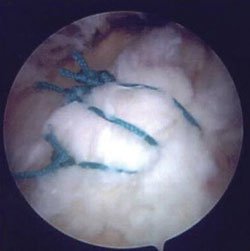Risk factors identified for poor results after revision rotator cuff repair
A recently presented study indicates that most patients had significant improvement in function following revision arthroscopic rotator cuff repair and identifies tobacco use, workers’ compensation and diabetes as risk factors for poor outcomes.
Judson Penton, MD, presented the results at the at the 2011 Annual Meeting of the Arthroscopy Association of North America.
“There’s very little information on outcomes or revision of arthroscopic rotator cuff repairs,” Penton said during his presentation. “Our purpose was to examine the outcomes of arthroscopic revisions of previously failed arthroscopic rotator cuff repairs.”
Study period
Penton and his team studied 75 revisions in 69 patients from January 2004 to July 2007. Patients presented with 35 small tears, 17 large tears, 12 massive tears and 11 medium tears. The investigators studied 30 men and 39 women. The group had an average age of 53 years. The investigators confirmed rotator cuff re-tears on MRI prior to revision. Time to revision surgery averaged 9.7 months.
|
Image: Penton J, Field LD |
The patients had a minimum follow-up of 2 years and an average follow-up of 42 months postoperatively. They had a minimum follow-up of 2 years. The team recorded Contant-Murley scores, tear size and any additional procedures performed. Additional procedures performed at the time of surgery included capsular release, subscapularis repair, biceps tenodesis, loose body removal and tendon augmentation.
Risk factors
The investigators indentified tobacco use, workers’ compensation and diabetes as independent risk factors for inferior outcomes. Combinations of two or more risk factors caused poor results. Forty-four of the 69 patients studied had two or more risk factors. Twenty percent of patients had fair results, and 14% had poor results.
Patients with one or no risk factors had better results. Sixty-seven percent of patients with one or none of the risk factors had good or excellent outcomes.
“Interestingly, patients with only one factor before healing showed no difference in Constant-Murley scores compared to those with none of these risk factors,” Penton said.
Overall, the investigators found a statistically significant increase in Constant-Murley scores. The score rose from 40.4 preoperatively to 79.6 postoperatively. Range of motion also improved from 89° to 152°. The study also showed that most patients, 86%, were satisfied with their results.
“There was a significant improvement realized in both motion and function,” Penton said. — by Renee Blisard
Reference:
- Penton J, Field LD, Savoie FH III, et al. Revision arthroscopic rotator cuff repair: A Prospective study. Paper #SS-13. Presented at the 2011 Annual Meeting of the Arthroscopy Association of North America. April 14-16. San Francisco.

- Judson Penton, MD, can be reached at MS Sports Medicine & Orthopaedic Center, 1325 E. Fortification St., Jackson, MS 39202. 601-354-4488; email: judsonpenton15@alumni.nd.edu.
- Disclosure: Penton has no relevant financial disclosures.

